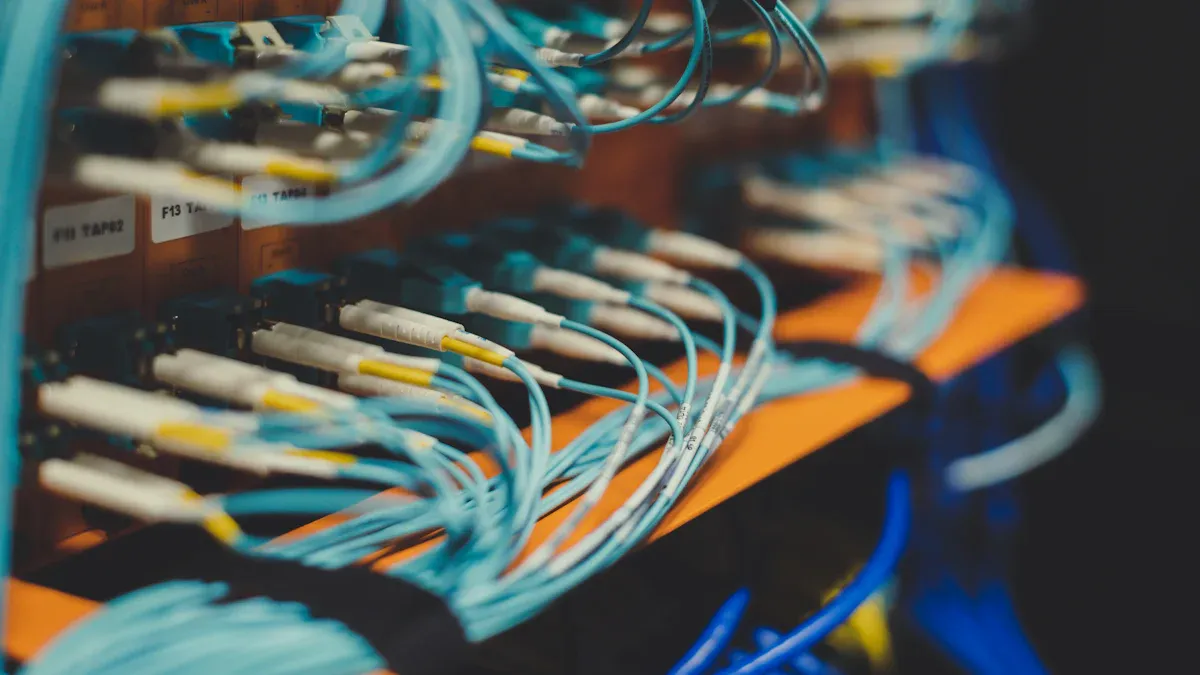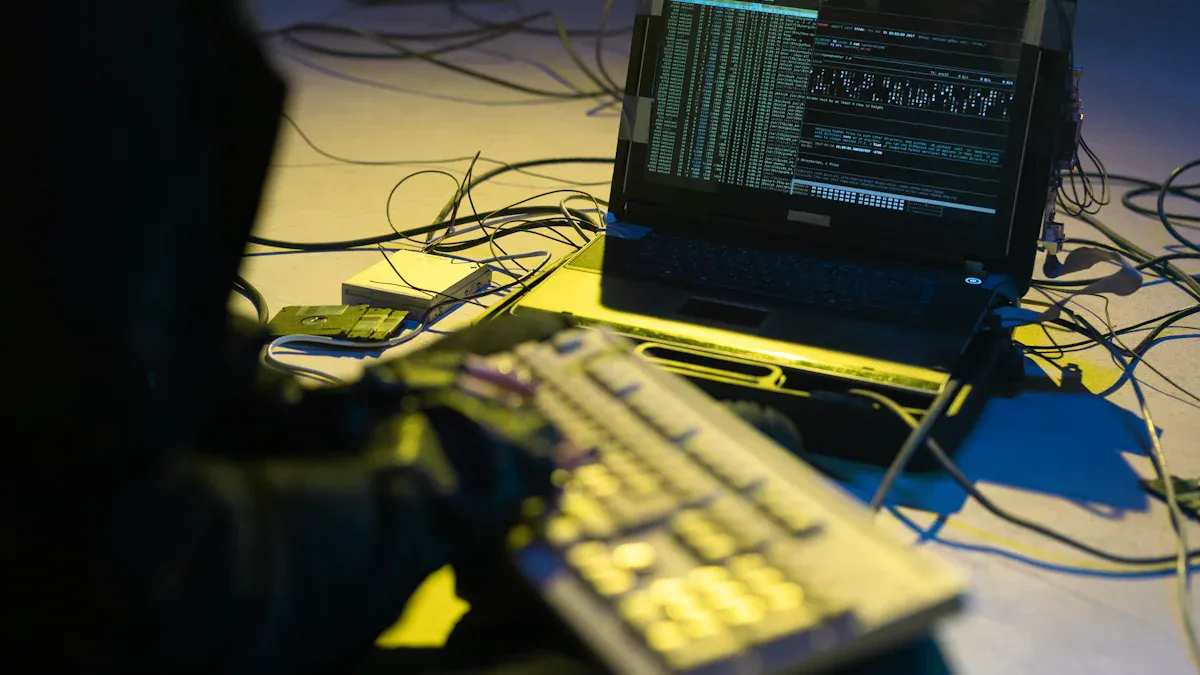Understanding Cybersecurity Risks in Modern Warehouse Management and How to Mitigate Them

Warehouses have big cybersecurity problems now. Digital systems connect more devices and processes. Cyberattacks happen more often and are worse. The table below shows how recent attacks hurt businesses and caused big losses:
Incident | Year | Impact |
|---|---|---|
KNP’s Ransomware Attack | 2023 | The company closed and 730 people lost their jobs. They could not recover from the attack. |
Stop & Shop Disruptions | 2024 | The supply chain was disrupted. There were shortages of fresh produce, meat, and dairy. |
Starbucks Payroll Challenges | 2024 | Payroll systems stopped working in 11,000 stores. Workers had to use manual processes. |
Japan Airlines Flight Delays | 2024 | More than 20 domestic flights were delayed. A cyberattack caused network problems. |
These examples show what can happen because of cybersecurity risks. Taking action early helps lower threats and keeps warehouses working well.
Key Takeaways
Cybersecurity risks in warehouses can cause big problems. Acting early helps stop these threats.
Unauthorized access is a big risk. Use strong access controls. Watch entry points to keep important areas safe.
Ransomware and phishing attacks can stop warehouse work. Teach staff to spot these threats. Make a plan to respond.
Regular security testing finds weak spots. Check often to keep systems safe and current.
Making a security culture with employees is very important. Keep training and practice drills. This helps staff act fast against threats.
Cybersecurity Risks in Warehouse Systems

Unauthorized Access and Data Theft
Unauthorized access is a big problem in warehouse management. Criminals look for weak spots to get inside. Poor lighting makes it easier for them to sneak in. If the outside fences are weak, intruders can enter the warehouse. Bad access controls let people go into areas they should not. The table below shows common problems:
Type of Incident | Description |
|---|---|
Neglected Access Security | Criminals can get in if doors are not locked. |
Poor Lighting | Dark areas help criminals and make cameras less useful. |
Insufficient Perimeter Security | Weak fences let people enter the warehouse easily. |
Weak Access Control Measures | Not enough checks let people into private zones. |
Data theft can happen from inside or outside the company. People who work there cause most data breaches. Outsiders cause fewer but still serious problems. Thieves steal cargo or truck parts from parked vehicles. Sometimes, workers take things from inside the warehouse. Visitors who should not be there can also steal data. These problems can hurt the business and its reputation.
Ransomware and Phishing Attacks
Ransomware and phishing attacks are dangerous for warehouses. Attackers use ransomware to lock computer systems. They ask for money to unlock them. The average ransom is $2 million. Recovery costs can be even higher. Warehouses may stop working for 24 days. It can take over 280 days to fix everything. Most companies do not get their data back after paying.
Phishing attacks trick warehouse staff with fake emails. More than 80% of companies saw more phishing since the pandemic. Seventeen percent had a data breach because of phishing in 2021. Almost 3% of phishing emails get clicked. This shows how easy it is to fall for these tricks. The table below shows the effects:
Evidence Type | Description |
|---|---|
Prevalence | Phishing is common in warehouse and freight work. |
Outcomes | Money loss, data leaks, and work stoppages happen often. |
Trend | Attacks get smarter and happen more each year. |
Ransomware and malware attacks stop work and put data at risk. Warehouses need strong defenses and smart staff to stay safe.
Operational Disruptions and Outages
Warehouse systems face many threats that can stop work. Cyberattacks can close supply chains and delay shipments. In 2025, 79 attacks hurt 690 businesses and 78 million people. Ransomware causes almost half of all breaches in factories. This makes it a big risk for keeping work going.
Cybersecurity outages slow down orders and create delays. Problems in supply chains make it hard to fill orders. If one part fails, it can affect the whole warehouse. The U.S. meatpacking industry had shortages because of cyberattacks. This shows how real these risks are.
Device and Network Security Risks
Warehouse systems use many devices and networks. These can be weak if passwords are easy to guess. Old network services and parts can be unsafe. Common problems include:
Easy or hardcoded passwords
Unsafe network services
Unsafe connections between systems
No safe way to update devices
Old or unsafe parts used
Not enough privacy protection
Unsafe ways to move and store data
No good way to manage devices
Unsafe default settings
Not enough physical protection
These problems make it easier for attackers to break in. Unsafe devices and networks can leak data and stop work. Good device management and updates help keep warehouses safe.
Supply Chain Vulnerabilities
Supply chain problems make warehouses less safe. Outside vendors may have weak security. This makes supply chains easy targets. The table below shows main risks:
Cybersecurity Risk | Description |
|---|---|
Costs for fixing problems and paying ransoms. | |
Data Theft | Stolen data makes customers lose trust. |
Legal Risks | Fines can be over $100 million. |
Brand Damage | Bad reputation and costs to pay customers. |
Supply Chain Vulnerabilities | Outside links with weak security raise risk. |
IT Vulnerabilities | Password leaks, phishing, and old systems cause problems. |
OT Vulnerabilities | Malware from USBs or laptops stops work. |
Insider Threats | Mistakes or bad actions by workers cause breaches. |
Mistakes by workers, weak cloud security, ransomware, and supply chain attacks all add to warehouse risks. In 2023, companies had more supply chain breaches than in 2022. If one company has a problem, it can hurt many others. This makes risks higher for warehouses.
Warehouses need to fix these problems to stay safe. Good cybersecurity, regular checks, and safe devices help lower risks and keep warehouses working.
Mitigating Cybersecurity for Warehouse Systems

Network Segmentation
Network segmentation helps smart warehouses stay safer. It splits networks into smaller zones. Attackers have trouble moving between these zones. This keeps important things safe. Warehouses separate operational technology from information technology. They make special zones for control systems like PLCs and HMIs. Segments with sensitive data are kept apart. This helps control who can get in and lets staff watch traffic.
Some benefits of network segmentation are:
Breaches stay in one place and do less harm.
Permissions and monitoring are easier to manage.
Watching each segment helps find problems faster.
Recovery is quicker and costs less after a breach.
Smart warehouses use VLANs to keep production areas separate. These rules help control who enters each zone. Network segmentation also helps find weak spots in each area.
Continuous Monitoring
Continuous monitoring helps smart warehouses spot problems fast. Security teams set up alerts for strange activity. They know what normal looks like and watch for changes. Teams train to handle alerts and write down what happens. Every few months, they check and improve their plans.
Good ways to monitor include:
Watching important places like data and apps.
Making alerts better so there are fewer false alarms.
Looking at signals from many sources for better checks.
Using AI to find small changes and cut down on noise.
Keeping logs ready for audits and investigations.
Matching monitoring with response plans and testing often.
Checking coverage with regular vulnerability tests.
Smart warehouses use cameras and sensors all day and night. Remote monitoring lets staff watch many places at once. Virtual guards respond quickly. Access control stops people who should not enter. Video analytics help find threats early. Multi-factor authentication adds extra safety for important systems. Intrusion detection blocks attacks by checking network traffic. Firewalls protect systems from bad traffic and malware.
Zero-Trust Security
Zero-trust security means no user or device is trusted at first. Identity and access management gives each person and device special credentials. Role-based access control sets who can see what. Permission checks find accounts with too much access.
Main parts of zero-trust security are:
Component | Description |
|---|---|
Policy Enforcement Point | Checks access and controls who gets in. |
Policy Administrator | Handles requests and talks between users and resources. |
Policy Engine | Always checks trust using different data. |
Continuous Diagnostics | Shows how safe resources are. |
Threat Intelligence | Shares info about attacks and weak spots. |
Identity Management | Manages accounts and gives access based on roles. |
Security Information and Event Management | Collects and studies security info to improve rules and spot threats. |
Zero-trust uses micro-segmentation to keep systems apart. Every access request is checked. Watching behavior helps find strange actions and malware early.
Regular Security Testing
Regular security testing helps smart warehouses find weak spots. Companies with important assets should test often. Big code changes need new tests. High-risk places test every few months. Small businesses may test once a year.
Scenario | Frequency |
|---|---|
Regulatory compliance | Yearly or after changes |
Small businesses with low risk | Yearly |
Large enterprises | Monthly or quarterly scans; yearly or twice-a-year penetration tests |
High-change environments | After big updates |
Post-breach investigation | Right after a breach |
Good testing checks who can access what. This keeps important info safe. Common threats like phishing, malware, ransomware, and data leaks need strong rules. Basic steps are using strong passwords, securing Wi-Fi, updating software, and backing up data. Finding weak spots in warehouse systems and devices helps stop supply chain attacks.
Incident Response Planning
Incident response planning helps smart warehouses recover fast after cyberattacks. Key steps include unplugging affected machines and keeping resources apart. Teams talk to people involved and write down what they learn. They look for clues and save evidence. They decide if the business plan needs to start. Writing notes on paper keeps plans secret from attackers. Playbooks guide the team through each step.
After stopping the attack, recovery starts. Teams restore systems from backups and bring important systems online. They test everything before using it again. Closing the incident and writing down what happened helps improve next time. Afterward, teams find out what went wrong, fix systems, block bad links, and use feedback to stop future attacks.
Phase | Impact on Recovery Time and Loss Mitigation |
|---|---|
Preparation | Sets up quick response and less downtime. |
Detection | Finding problems early means less damage. |
Containment | Stops spread and keeps other systems safe. |
Eradication | Removes threats for safer recovery. |
Recovery | Gets things working again faster. |
Lessons Learned | Makes future responses better and stops repeat problems. |
Setting clear roles, making strong plans, and writing down each step help smart warehouses stay safe. These steps support checks for weak spots and make cybersecurity stronger.
Building Warehouse Security Culture
Employee Training and Awareness
A good warehouse security culture needs workers to help. Employees are important for finding threats and acting fast. Training teaches staff to spot strange actions and tell someone. Drills show everyone what to do if there is a breach. Clear rules and learning all the time keep security strong.
Description | |
|---|---|
Employee Involvement | Workers look at problems and act quickly. |
Basic Security Training | Staff learn to spot and report strange actions. |
Regular Drills | Drills get workers ready for security problems. |
Effective Security Protocols | Physical security, access control, and cameras are needed. |
Security Audits and Assessments | Checks find weak spots and make security better. |
Special training helps with warehouse security problems. Doing training often helps people remember. Games make learning fun and help people want to learn. These ideas make warehouse security better and lower risks.
Access Control Management
Access control is very important for warehouse safety. Setting up roles and permissions keeps private areas safe. Systems check who people are and what they can do. Watching what users do helps see who comes and goes. Teaching users about access control helps keep the warehouse safe.
Set up roles and permissions for each job.
Use systems to check who people are.
Watch and check user actions for strange things.
Teach users about access control and safety.
Look at and change access rules often.
Use a safe warehouse system with strong access control.
Evidence Description | |
|---|---|
Only allowed people can go into special places. | Makes it less likely for someone to get in without permission. |
Access control lets only trained staff into private areas. | Stops accidents and helps follow safety rules. |
Tracking every entry and exit with digital logs gives proof. | Shows who was there if something happens. |
Strong access control keeps inventory safe and stops theft. | Keeps valuable items from being stolen or lost. |
Good warehouse security needs strong access control rules. These steps keep inventory safe and stop people from getting in without permission.
Vendor and Third-Party Security
Vendor and third-party security is important for warehouse safety. Companies must check how safe their vendors are to protect themselves. Attackers try to break into supply chains by finding weak spots. Good warehouse security means always checking and watching vendors.
Description | |
|---|---|
Set Performance Goals | Make rules for vendor safety and trust. |
Always Watch Vendors | Check and look at vendors often. |
Vendor Risk Rules | Make steps for handling vendor risks. |
Plan for Problems | Get ready for vendor security issues. |
Make a VRM Team | Have a group to watch vendor risks. |
A bank kept data safe and saved its good name by acting fast when a vendor had a security problem. This shows how good warehouse security can stop harm from vendor mistakes.
Companies use access controls to share private info with vendors. Inside alerts show changes or problems with vendors. Watching and checking vendors helps find risks. These steps keep warehouse security strong and lower risks from vendors.
Warehouse managers need to watch for cybersecurity risks all the time. Good defenses and a security-first culture keep operations and data safe. Teams should check for risks often to find weak spots. They can get help from cybersecurity experts.
Training that happens often and clear rules help everyone know their job in warehouse security.
A safe warehouse keeps goods moving and makes customers happy.
Next Steps:
Plan regular security checks
Look at and change safety plans
Talk to cybersecurity professionals
FAQ
What is the biggest cybersecurity risk for warehouses?
The biggest risk is unauthorized access. Attackers might steal data or stop work. Using strong access controls helps keep systems safe. Checking systems often also protects warehouses.
How does ransomware affect warehouse operations?
Ransomware locks up important systems. Workers cannot fill orders or check inventory. Fixing the problem takes time and money. Having a quick plan helps lower the damage.
Why is employee training important for warehouse security?
Employees can find threats early. Training shows them how to report problems. It also teaches them to follow safety rules. Drills help staff get ready for real events.
How can warehouses protect devices and networks?
Warehouses use strong passwords and update software often. Firewalls and special systems help block attacks. Regular checks help find weak spots in the system.
What should managers do after a cyberattack?
Managers follow their response plans. They keep affected systems apart and use backups. Teams look at what happened and make security better.
See Also
Revolutionizing Online Store Management With AI-Driven Tools
Understanding AI-Enhanced Corner Stores: Essential Insights for Retailers
Analyzing Walgreens Self-Checkout: Benefits and Obstacles in Retail
Upcoming Changes to Walmart Self-Checkout Access by 2025
How Cloudpick's Checkout Systems Improve Efficiency and Customer Satisfaction
